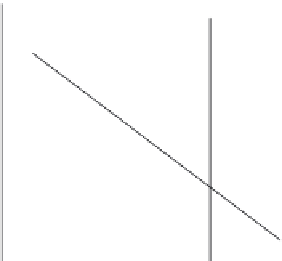Agriculture Reference
In-Depth Information
Local cereal price
Local supply
Positive weather shock
Equilibrium
Negative weather shock
Local import parity price
Max. equilibrium price
Large transaction/
trade costs
Equilibrium price
Min. equilibrium price
Local export parity price
Local demand
Demand
Qty Supply/Demand
FIGURE 7.2
Local supply shocks determine equilibrium local prices in an isolated food surplus
market (source: Kshirsagar, 2012).
Local supply with
favorable weather shock
Local cereal price
Local supply
Equilibrium
Local import
parity price
Local export
parity price
Local demand
Max. equilibrium price
Tr ansaction/trade costs
Equilibrium price
Min. equilibrium price
Demand
Qty Supply/Demand
FIGURE 7.3
Local supply shocks partially determine equilibrium local prices in a connected food
surplus market (source: Kshirsagar, 2012).
For a chronically food deficit location, we would not expect to observe a significant rela-
tionship between local weather shocks and local food prices. World prices may influence local
prices in this area, but this will depend on, among other factors, transport costs, government
policies and whether markets are functioning properly.
Basic economic reasoning can provide guidance in linking a location's characteristics to
the likelihood of it being affected by local weather and/or world price shocks. Given the
variety of factors that are likely to influence market functioning, considerable heterogeneity
among locations is likely, even within a country and perhaps within an agro-ecological zone,
regarding the influence weather and external shocks have on local price formation.
The model uses both international food prices and spatially explicit information on weather
shocks to study food market functioning to provide useful guidance regarding areas that are
most likely to benefit from marketing/supply chain interventions or food aid. The model






















Search WWH ::

Custom Search